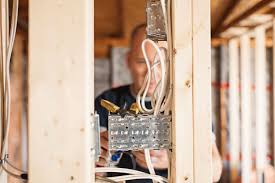Electricity runs our modern lives, but it can also disrupt them when things go wrong. Ensuring your electrical systems are up to code from the get-go is crucial, which is why a rough electrical inspection is so important.
In this blog post, we’ll explore the top red flags to look for during a rough electrical inspection. By the end, you’ll know exactly what to watch out for and how to ensure your electrical system is safe and compliant.
Inadequate Grounding
One of the most critical aspects of any electrical system is proper grounding. Grounding provides a safe path for electricity to follow in case of a fault, reducing the risk of electric shock and fire.
Common Grounding Issues
Common grounding issues include missing ground wires, improper connections, and inadequate grounding electrodes. These problems can compromise the safety and functionality of the electrical system.
How to Spot Grounding Problems
During the inspection, check for continuous ground paths and proper connections. Make sure all grounding conductors are firmly attached. Also, install the grounding electrodes per the code.
Overloaded Circuits
Overloaded circuits are a common issue that can lead to overheating and fires. Ensuring that circuits are not overloaded is a key part of any rough electrical inspection.
Identifying Overloaded Circuits
Signs of overloaded circuits include the use of too many devices on a:
- single circuit
- undersized conductors
- and improper breaker sizes
Check the circuit layout and ensure that each circuit is appropriately rated for its load.
The Dangers of Overloading
Overloaded circuits can cause wires to overheat, potentially leading to fires. They can also result in frequent breaker trips, reducing the reliability of the electrical system.
Improper Wire Connections
Proper wire connections are essential for ensuring the safety and reliability of an electrical system. Improper connections can lead to arcing, overheating, and even fires.
Types of Improper Connections
Improper connections can include loose wires, incorrect splicing, and the use of the wrong types of connectors. During the inspection, check all wire connections to ensure they are secure and correctly made.
Spotting Worn or Damaged Wires
Worn or damaged wires can also pose a risk. Look for signs of wear, such as frayed insulation or exposed conductors, and replace any damaged wires immediately.
Inadequate Panel Access
The electrical panel is the heart of the electrical system, and it must be easily accessible for maintenance and emergencies. Inadequate panel access can hinder these efforts and pose a safety risk.
Electrical codes require a certain amount of clearance around the electrical panel to ensure safe access. Measure the clearance around the panel and ensure it meets electrical code requirements.
Missing or Improperly Installed GFCIs
GFCIs protect against electric shock. They shut off power when they detect a ground fault. They are required in areas where water is present, such as kitchens and bathrooms.
During the pass rough electrical inspection, check that GFCIs are installed in all required locations. Ensure they are properly wired and functioning correctly.
A home inspector plays a crucial role in ensuring the safety and functionality of a property’s electrical system. The inspector will thoroughly assess the electrical components during a home inspection. They will identify potential hazards, as discussed in previous sections.
Exploring the Red Flags to Look for During a Rough Electrical Inspection
In conclusion, a thorough rough electrical inspection is vital. It ensures the safety, reliability, and compliance of an electrical system. Electrical inspections protect property and occupant safety.
Fixing problems found during the inspection phase makes the electrical system safer and more efficient.
For more helpful tips, check out the rest of our houseyzone site today.


